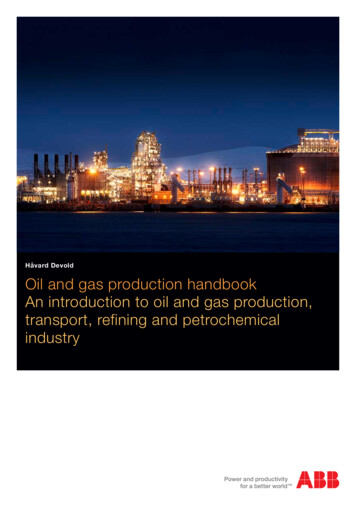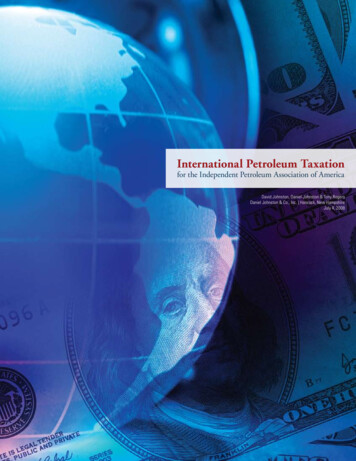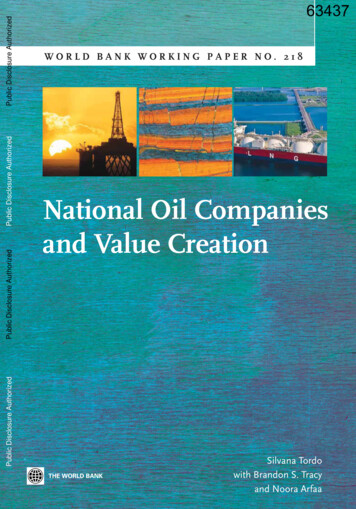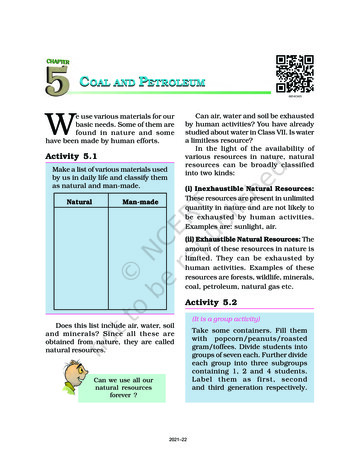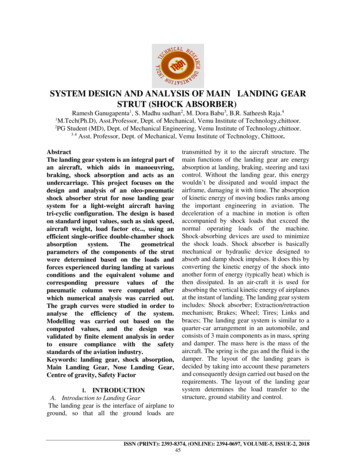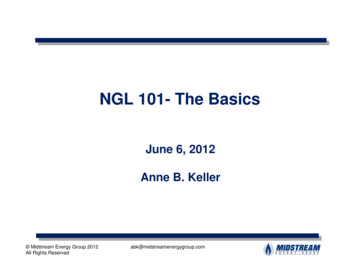
Transcription
GLOBAL TRENDS IN OIL & GASMARKETS TO 2025
TABLE OF CONTENTSGlobal oil market outlook3Global trends in refining22Global natural gas market outlook30Challenges for Russian oil and gas industry42Conclusion591
TRENDS IN GLOBAL OIL & GASMARKETS TO 2025The present outlook reflects LUKOIL’s position regarding include the growing cost of reserve replacement, theglobal hydrocarbon market long-term prospects. The balancing role of OPEC and depreciation of US dollar willoutlook’s objective is to analyze trends that will - in our help to support the current levels of oil prices in long term.view - determine the future of global oil and gas markets. The European oil refining industry is experiencing aSuch analysis is prepared by the Company on a regular systemic crisis. Such ongoing trends as the decrease inbasis in order to keep the strategy up to date and to form US gasoline imports and commissioning of new highlythe investment program. However, this is the first time that effective oil refineries in the Middle East and Asia willwe are making such analysis public.continue to have a long- term negative effect on Europeanproducers.By publishing such outlook we hope that it will help toclarify the current situation on the oil and gas market and Gas consumption will grow faster than oil consumption.will draw attention to the challenges that face the global The greatest potential for gas consumption growth is inoil and gas industry.China, while the European markets - Russia’s traditionalclients - will continue remain stagnant.Analysis of the current problems of Russia’s oil and gasindustry in the context of the main trends of global oil and Maintaining oil production in Russia requires largegas markets’ development is an especially important part scale use of new technologies. The currently plannedof this outlook.projects are unable to compensate production decline onbrownfields. Without large-scale use of new technologies,Key conclusions of this outlook:oil production in Russia will begin to fall in 2016-2017. Global demand for liquid hydrocarbons will continue togrow. Growth of population and consumer class in Asiawill support oil demand increase. The main increase inconsumption will come from transportation sectors indeveloping countries. Increase of oil production in North America won’tlead to a global oil prices collapse. Modern methodsfor evaluation of shale oil reserves allow considerableuncertainty therefore we are cautious in our estimates ofthe US production potential. A number of factors that2 The Russian oil refining industry will undergo significantmodernization but risks of gasoline deficits remain.Measures taken by the Russian government will promotemodernization of domestic oil refineries but the situationon the automotive gasoline market will remain quite tenseuntil 2016-2017. Main challenge for Russian gas industry is the access tothe new markets. Competition on the global gas marketswill continue to rise. To develop gas production in Russia,Russian companies have to gain access to growingmarkets.
GLOBAL OIL MARKET OUTLOOK3
GROWTH FACTORS AND CHALLENGESFOR OIL MARKETGlobal oil price dynamics are subject to many factors, theprincipal of which are the balance of supply and demand,macroeconomic and geopolitical situation, dynamics ofthe US dollar exchange rate and conditions on the globalfinancial markets.Technological breakthroughs make it possible to develophuge resources. The increase in unconventional oil andgas production in the US serves as a good example.Taking into account the US oil production progressmany analytical agencies lower their long-term oil priceforecasts.Growth factors: Population growth, urbanization Motorization in Asia Growing costs of exploration and production OPEC policy Dollar depreciationPrincipal challenges: Increase of unconventional oil production in NorthAmerica Increase of oil production in Iraq Deepwater shelf production Biofuels production growthAt the same time a number of trends will support oil prices Gas to liquids (GTL) expansionin the medium term.In this outlook we would like to specify these trends andcritically analyse a number of challenges that oil industryface nowadays.Supply and demandUS Dollar exchangerateMacroeconomicsituationOil priceFinancial markets4Geopolitics
DEMOGRAPHIC FACTORSOur planet’s population will continue to grow rapidly. At the same time the levels of consumption will grow. ItBetween 2010 and 2025 global population will grow by is expected that by 2025 the size of the urban consumermore than 1.1 bln people.class will grow by 1 bln people and overall middle class willamount to more than 50% of the total global population.Greatest population growth will be registered in the The main growth will come from the developing Asiandeveloping countries, while in the developed countries countries.population will remain relatively stable.Urbanization and growth of the consumer class inHigh rates of population growth are expected, first of all, developing countries will, in turn, promote growth inin India, which will become the world’s most populous demand for real estate, infrastructure, cars, hi-tech goodscountry by 2020. Explosive population growth is also and, as a result, energy resources.forecasted for the African countries where it will be theresult of improvement in socio- economic conditions andquality of medical services.Along with population growth, developing countrieswill experience the movement of rural population to thecities, known as urbanization. According to the estimatesof Mckinsey Global Institute, by 2025 440 cities in thedeveloping countries will contribute up to half of the globalGDP growth.Global population, blnDeveloped countriesShare of consumer class in global population, %Developing countriesSource: UN, IHS CERA, Mckinsey Global Institute5
OIL DEMANDDemand for liquid hydrocarbons will continue to grow. In addition to this, growth in demand for oil in theGlobal demand for liquid hydrocarbons will continue developing countries will be further encouraged by theto grow annually by 1.2% on average and will, in our industrial sector, in particular, the petrochemical industry.estimates, reach 105 mb/d by 2025.At the same time, consumption of liquid hydrocarbonsThe greatest surge in oil demand will come from the in the developed countries will remain relatively stabletransportation sector, for which oil is the principal energy due to the low rates of economic growth and furthersource (over 90%).improvements of fuel economy.Consumption of liquid hydrocarbons will increase in thedeveloping countries where the transportation industryis undergoing rapid growth. Analysts expect to seesignificant growth in the number of cars as well as thedevelopment of sea, air and railway transportation.Forecast for consumption of liquid hydrocarbons, mb/dDespite stable growth rates oil’s share in the globalconsumption of energy resources will gradually decrease,because of substitution for other energy sources in suchsectors as power generation and housing.Pattern of energy resource consumption in the transportationsector, %Transportation sector of developing countriesTransportation sector of OECD countriesOther industriesElectricity6Sources: IEA, IHS CERA, LUKOIL estimatesGasOtherOil
MOTORIZATION IN ASIAN COUNTRIESThe motorization of the population in the developingcountries is one of the principal factors of the futuregrowth in demand for oil. Today the developing countriesare severely lagging behind the developed ones in termsof the number of cars per 1,000 people, thus creatingconditions for significant growth in the size of the globalcar fleet.Significant growth in car ownership will also be registeredin India and other developing Asian countries. By 2025large-scale growth of car ownership will begin in Africa.Freight cars and trucks will make a strong contribution tothe growth in consumption of motor fuels. Total number ofsuch cars is expected to grow by 140 mln by 2025.In the forecast period, the most noticeable increase in car According to our estimates, the aggregate global carownership will take place in China, whose car market has fleet will grow by 670 mln over the period of 2010-2025.already entered intensive growth stage. In today’s China Leading to increase in fuel consumption by 9 mb/d.the number of cars per 1,000 people is 40. By 2025 thisfigure will be close to 200, leading to 220 mln car fleetincrease for the period of 2010-2025.Car fleet growth in certain regions, 2010-2025,mln of carsMotorization curvesPassenger cars/1000 people- LDVS 2010Boom stage- TRUCKS 2010- GROWTHEuropeNorthAmericaChina2025AsiaChina2010GDP per capita, 2011NorthAmericaSources: IEA, OPEC, World Bank, PFC Energy, LUKOIL estimatesEuropeChinaIndiaLatinAmerica7
FUEL ECONOMY IMPROVEMENTWe are currently observing a sustained trend towardsdecrease of fuel consumption in passenger cars. This ishappening for a number of reasons: the designs of carbodies and engines are improving, the quality of enginefuel is getting better and hybrid technologies are beingimplemented more often.Growth in the size of car fleet will be accompanied bychanges in its structure. However, over the course of thewhole forecast period internal combustion engines willpreserve their dominant position. Their share in the totalcar fleet will amount to more than 80%. At the same timethe share of cars with diesel engines will slightly increase.Consumption of fuel by new cars, l/100 kmThe decreased rate in fuel consumption over the last 20years was due to the improvement in its quality. Enginesthat consume RON-95 gasoline became an industrystandard. The further decrease in fuel consumption ratewill be evolutionary, not revolutionary.Promising trends in car improvement, such as thehybrid engines, reduced rolling resistance tires, decreasein weight and improvement in aerodynamics, will help toreduce consumption of fuel in passenger cars by 30% by2025.Structure of car fleet,%- gasoline- FFV*- electric cars- gasEU8USASources: IEA, PFC Energy, LUKOIL estimates- diesel- hybrid- LPGChina*Flexible fuel vehicle - cars with flexible choice of fuel (the car can use either gasoline or amixture of gasoline and ethanol in flexible proportions)
UPSTREAM COSTS INCREASEThe last decade was characterized by the unprecedentedgrowth of exploration and production costs. Accordingto the current estimates, oil companies expenditures ongeological exploration, development and production havemore than tripled since the beginning of 2000s.Therefore, even if demand for oil falls significantly, itsequilibrium price is unlikely to stay below 70-80/bbl forlong.Future growth in production will primarily come from thedevelopment and operation of unconventional reserves.In 2010-2025 over 70% of increase in supply of liquidhydrocarbons will come from the use of hi-tech productionmethods and alternative fuels such as natural gas liquids(NGL), GTL/CTL and biofuel.In many ways the increase in costs is tied to the depletionof convention oil resource base. The growing demand forhydrocarbons forces companies to develop unconventionaland highly costly reserves. The companies are producingoil from deepwater shelf, operating high viscosity oil fieldsand extracting oil from tight reservoirs.The greatest increase in production will come from thedeepwater shelf, tight oil reservoirs in the US, heavy crudeIn today’s market about 15 mb/d have commercial from Canada and Venezuela. we also expect increase inproduction costs above 70/bbl. for example, shale oil production of NGL, primarily in the Middle East and in theprojects in the US on average are profitable at the 80/ US.bbl cost of oil.Dynamics of capital and operating costs inexploration and production /boeForecast for changes in supply of liquid hydrocarbons in2010-2025, by sources, mb/d /bblBiofuelsOPEX (left axis)capex (left axis)CTL/GTLNGLBrent price (right axis)Heavy Venezuelanoil, Canadian sandsTight oil reservoirs andshale oil in the USConventionalregionsDeepwater shelfDevelopment of newconventional reserves(Iraq, Saudi Arabia, CIS)Sources: IEA, IHS CERA, IHS Herold, LUKOIL estimates9
US SHALE OIL PRODUCTION OUTLOOKDevelopment of horizontal drilling and hydraulic fracturingtechnologies made profitable a significant amount ofunconventional hydrocarbon reserves in the UnitedStates. This began with active production of shale gaswhich led to the collapse of spot gas prices.In 2012 the aggregate volume of oil production fromunconventional reservoirs in the Us is estimated to haveequaled 1.2 mb/dy.The transportation and refining infrastructure wasunprepared for such production growth and that led toHigh oil prices in 2011-2012 forced many companies to decrease in the US oil prices. Average spread betweenstart active drilling of unconventional reservoirs containing Brent and WTI oil amounted to 17/bbl in 2011-2012, whileliquid hydrocarbons. In 2011 the number of drilling oil rigs several years before WTI sold at a premium to Brent.in the US exceeded the number of gas rigs.Growth in shale oil production in 2011-2012 was veryimpressive. Oil production at Bakken formation in NorthDakota increased by more than 7.5 times and amountedto 589,000 b/d in 2012.Eagle ford play in Texas also became the site of explosivegrowth in liquid hydrocarbon production.Average oil production at Bakken*, kb/dHydrocarbon output at Eagle Ford, kboe/dgas* For counties in North Dakota10Sources: IEA, IHS CERA, IHS Herold, LUKOIL estimatescondensateoil
US SHALE OIL PRODUCTION OUTLOOKUNCERTAINTY IN RESERVE ESTIMATIONShale oil reserves are characterized by low permeability.Hydraulic fracturing technology is used to improvethe oil inflow. well flow rates in shale formations arecharacterized by high decline rates in the first year ofproduction - generally they amount to 60-70% of themaximum flowrate.HISTORICAL AVERAGEHYPERBOLICEXPONENTIALkb/monthShale oil reserves in the US have undergone severalrevisions in the last few years. In 2008 US Geologicalsurvey (USGS) estimated recoverable oil reserves atBakken formation at 3,65 bln. In 2013 USGS increasedthe reserves estimates to 7,4 bln bbl. In 2011 ContinentalResources valued recoverable reserves at 20 bln bbl.Average Bakken well production curveSTRETCHED EXPONENTIAL CURVEThe principal instrument of reserve estimation is productioncurve analysis where production curves are derived fromMonthsactual data of well flow rates by approximation. When the The value of estimated ultimate recovery (EUR) dependsperiod of well’s operation is small, forecasts for different on the chosen method of calculation and data available.production curves may vary significantly.Estimates may significantly vary for different groups ofwells, depending on the quality of formation, hydraulicThe majority of wells in the Bakken formation currently fracturing technology and other factors.only have data for 3-4 years of actual operations, leading Hence, an overstimation of shale formation reserves isto significant discrepancies in existing estimates.possible.EUR estimates for Bakken formation, kb/dLUKOIL estimates for wells of 2004-2007LUKOIL estimates for wells of 2008-2010Estimates of Mason J. (2012), Oil & Gas Journal for wells of 2011A - Hyperbolic, B - Duong, C - Extended exponential, D - Hyperbolic Dmin, E- Exponential11
US SHALE OIL PRODUCTION OUTLOOKPOTENTIAL FOR WELL DRILLINGWhen forecasting shale oil production, it’s necessaryto take into account the potential for well drilling. Themaximum number of wells will depend on the productivearea of land suitable for drilling and on well spacing.According to the current estimates, the maximum numberof wells that can be drilled at the Bakken formation inNorth Dakota is 33,000-39,000.According to our estimates, daily oil production of 2 mbat the Bakken formation is unlikely to be sustainable,because in this case the drilling potential will be depletedby 2022-2025. The most likely scenario of Bakkenformation development is to reach the production level nothigher than 1.5 mb/d by 2020.To support consistently high levels of production theAs the density of well spacing grows, EUR decreases, and companies will have to continue increasing the number ofthis should also be taken into account when forecasting active drilling rigs, leading to the need to hire more drillingfuture production.crews. According to the 2012 poll conducted by NationalOilwell Varco, availability of qualified drilling crews is oneIntensifying shale oil production by increasing rates of of the principal challenges for the US drilling companies.It is possible that another substantial constraint for thedrilling will lead to fast reserve depletion.growth in shale oil production in the US will be hydraulicfracturing crews shortage.Influence of well spacing on recoverablereserves per wellForecast for number of wells in Bakken formation*EUR per well, kbMAXIMUM NUMBER OF WELLSProduction - 1,5 mln bbl/dayProduction - 2 mln bbl/dayWell spacing, acres per well* For counties in North Dakota12Sources: Mason J. (2012), Oil & Gas Journal, LUKOIL estimates
OTHER CONSTRAINTSShale oil production requires the use of large quantities ofwater. Hydraulic fracturing requires 5-19 mln liters of water.This may become an impediment in certain productionregions.Some experts express concern that the use of hydraulicfracturing may lead to rock movement and deformation,and this, in turn, can provoke landslides and restrictconstruction.There are also certain concerns regarding theenvironmental safety of shale oil production. Whenhydraulic fracturing is underway in shallow depth, thecompanies may inject chemical reagents into the groundwaters. There may also be problems with utilization ofused chemical solutions.Considering this list of constraints, we forecast that shaleoil production in the US will amount to 3.9 mb/d by 2025.Shale oil production growth is expected primarily at themost developed formations of Bakken and Eagle ford.Taking into account well flow rates, the pace of drilling andthe productive area, the most intensive growth in shale oilIn addition, experts note that shale oil production is production in the US will take place in the next 5-10 years.associated with emission of methane and other dangerous After that production will stabilize.compounds into the atmosphere.Forecast for shale oil production in the US, mb/dSources: EIA, LUKOIL estimates13
NORTH AMERICA BECOMES THE LEADERIN PRODUCTION GROWTHFor the next decade North America will remain the leaderin terms of growth in production of liquid hydrocarbons.By 2025 the aggregate volume of liquid hydrocarbon andbiofuel production in the US and Canada will amount to 19mb/d, thus significantly reducing the region’s dependencyon oil imports.Just several years ago few believed that such growth ispossible in a region with consistently declining productionat brownfields. But large-scale deployment of innovativetechnologies has forced many to review their evaluations.The United States will continue to increase liquidhydrocarbon production with the help of shale oil,development of deepwater shelf and growth in NGLproductionIn Canada production growth will primarily depend onthe oil sands. By 2025 production of high-viscosity oilin Canada will reach 3.6 mb/d, which is 1.7 mb/d morethan this year. Production growth in Canada may besignificantly constrained by logistics and environmentalconcerns.Forecast for production of liquid hydrocarbons in North America*, mb/dConventionalDeep waterShale oilOil SandsLPGBiofuel14Sources: EIA, IHS CERA, LUKOIL estimates*Excluding Mexico
BIOFUELSAccording to our estimates, rapid growth in biofuel The United States are the world’s largest biofuelconsumption that the world has been experiencing since producer, but situation there is also far from optimistic.mid-2000s is unlikely to be repeated.It was believed earlier that development of biofuels isa strategic necessity capable to decrease AmericanEuropean biofuels have high production costs and dependency on imported oil. But the growth in productionuntil recently have been developed with the help of of unconventional hydrocarbons has reduced the role thatsubsidies. In Germany, for example, cost of biodiesel biofuels were meant to play in the provision of Americanproduction is almost two times higher than the cost of energy security.production of regular diesel fuel. The crisis, however, isforcing the European governments to cut biofuel subsidy Many experts doubt whether biofuel production isprograms and, as a result, many European producers are justifiable from the environmental point of view, since, asa rule, production of fuel from crops requires fossil fuels.experiencing losses.In addition to this, the European Commission has Taking the stated circumstances into account, we have aproposed to lower the target level of 1st generation biofuel rather conservative view of the future biofuel prospects.consumption to 5% of the total volume of motor fuelconsumption, while the current target level is 10%. If thissuggestion is passed, it will have a negative effect on theconsumption of biofuels in Europe.Self cost of fuel production in 2010*, euros/lForecast for global biofuel production, mln bbl/day** EXPERTFORECASTS:DIESELBIODIESELCuts in subsidies*, euros/lLUKOILFORECASTSubsidiesExcise tax on biodiesel* Germany caseSource: International Institute for Sustainable Development** As of the end of 201215
DEEPWATER PRODUCTIONAs traditional onshore reserves are depleted, offshoreresources are playing a greater role in securing thegrowing demand. The growing interest in shelf resourcesis illustrated by the fact that over the last 20 years thenumber of large shelf discoveries has been greater thanthe number of big onshore discoveries.Accident at the Deep Water Horizon drilling platform in theGulf of Mexico has forced many companies to review theirapproach to safety measures during shelf drilling. This willlead to growing operating costs for offshore projects.High tax burden in certain countries, such as Angola andNigeria, will also lead to growth in production costs.Today, proven offshore reserves are valued at 280 blnbbl, while shelf production amounts to 30% of the global We estimate the oil price for profitable development ofdeep water reserves should be at the level of 50-90/bblproduction.depending on the region of production and water depth.Technological development helps the oil companiesto increase the depth of offshore fields. About 27% of Despite the high cost of production and operating risks,shelf production is currently at the depths of 300 m and deepwater production will continue to grow. After 2015,more and with time this share is set to grow. Today the when a number of new large fields will be put in operation,technology allows producers to drill at depths that exceed we expect to see significant production growth.3,000 m. However, development of such reserves requiresmultimillion-dollar investments.Number of large discoveriesOFFSHOREONSHORE% OFFSHORE1900 1910 1920 1930 1940 1950 1960 1970 1980 1990 200016Sources: IHS CERA, Statoil presentation to the IEF, LUKOIL estimatesDeepwater production forecast, mb/dAngolaLatin AmericaOther countriesNigeriaNorth America
IRAQI PRODUCTION GROWTH PROSPECTSIraq remains the most promising region in terms ofconventional oil production growth. despite the country’simpressive proven reserves that amount to 143 bln bbl,production levels remain relatively low - and in 2012amounted to 3.1 mb/d.In addition to the deficit of export capacities, operatingcompanies have to deal with shortage of drilling rigs, deficitof water resources for maintenance of reservoir pressureand lack of developed transportation infrastructure fordelivery of goods and equipment.In the process of distributing licenses in 2009 thegovernment of Iraq announced its goal of achieving dailyproduction levels of 12 mb by 2020. Later the target levelof production was lowered to 9-10 mb/d, but today eventhis level seems overly optimistic.To reach the 9 mb/d production level by 2020 Iraq has toincrease production at the rates that Saudi Arabia did atthe end of 1960s-beginning of 1970s, or twice as fast asRussia in 2000s. Taking existing limitations into account,such growth rates are unlikely.Existing oil pipeline infrastructure is barely managing the We forecast that by 2020 oil production in Iraq will reachvolume of oil exports and development plans show that to 6 mb/d.the hopes for resolution of existing logistical bottlenecksin the near future are futile.Dynamics of oil production growth, mb/dProduction of 12mb/d ( 1,13)Forecast for oil production in Iraq, mb/dProduction of 9mb/d( 0,75)Saudi Arabia( 0,75)1966-1974Iran ( 0,35)1967-1975Russia ( 0,41)2000-2008LUKOIL forecast2012-2020 ( 0,38)Iraq ( 0,15)1972-1980Sources: IEA, LUKOIL estimates17
OPEC’S BALANCING ROLEToday OPEC countries control about 42% of global oilproduction. Thanks to their coordinated actions, cartelmembers are capable of rapidly reacting to changes in themarket situation by introducing production quotas. suchactions helped to stabilize oil prices rather quickly duringthe global financial crisis of 2008.Oil prices act as a decisive factor for budget revenueplanning of OPEC countries. As a result of the Arab Spring,budgetary obligations of certain cartel members havegrown significantly. According to the existing estimates,breakeven price that allows the Saudi Arabia to balanceits budget was about to 78/bbl in 2012.Price of oil necessary to balance Saudi Arabian budget, USD/bblBrent priceIf budget expenses growby 12% each year(mean for 10 years)Sources: Deutsche Bank, PIRA, LUKOIL estimatesIn medium term, as production by independent producers,especially the US and Canada, grows, OPEC members willlimit the growth of their own production, thus supportingthe global oil prices at necessary levels.Dynamics of OPEC share in global production, mb/dOPECSaudi Arabia threshold price18The probability of further budget expenditures growthneeded to stimulate the economy and implementinfrastructure projects is quite high for the next 2-3 years.for example, saudi Arabia’s budget for 2013 envisionsincrease of 19% in budgetary expenditures. Therefore itshould come as no surprise that Saudi representativesregularly voice the price of 100/bbl as the target level.IndependentOPEC share
GTL – CHALLENGE FOR THE OIL MARKET AFTER 2020One of the most promising alternative to the oil fuels is theGTL technology. This technology, based on the synthesisof liquid fuels from coal or methane, has been used backin 1940s in Germany, which experienced shortage of oilduring the World War II.The only project currently under construction is theEscravos GTL in Nigeria. A relatively small number ofactive and planned projects is a result of the high costs ofbuilding GTL refineries.Over the next few years the GTL technology won’t presenta serious challenge for the oil industry. But beyond a fewyears the situation may radically change due to furtherdevelopment of methane conversion methods. Among thepromising methods is the microchannel technology thatmakes it possible to substantially reduce the physical sizeToday revival of interest in this technology is a result both of reactors, leading to reduction in capital investments inof the stricter environmental requirements for the motor construction.fuels and of the possibility of operating gas fields inregions lacking gas transportation infrastructure.We believe that development of the GTL technology mayhave a significant influence on the oil market after 2020.The largest active GTL project today is Pearl GTL. Сurrent Should the GTL technology gain large-scale circulation,it’s possible we’ll see the spread between oil and gasmarket prices make it profitable.prices to narrow.GTL technology makes it possible to refine methane fromthe natural gas into a wide spectrum of products, the mostimportant of which are the diesel fuel and kerosene withimproved environmental credentials.History of GTL process19
INFLUENCE OF THE DOLLAR EXCHANGE RATESince the oil prices are denominated in USD, dynamicsof American currency’s exchange rate will influence theglobal oil prices. As a rule dollar depreciation leads togrowth in oil prices, while dollar appreciation does theopposite.Over the last decade we’ve been seeing a trend towardsdollar depreciation against other global currencies. Inmany ways this is a result of the US monetary policy.Depreciation of the dollar stimulates the US economyby having a positive influence on exports. Along withThe influence of the dollar exchange rate on oil prices can the economic growth, the currencies of the developingbe illustrated by comparing dynamics of oil prices in USD countries, especially the ones from the Asia Pacific region,with oil prices, denominated in Swiss francs and gold. are appreciating.Over the period of 2000-2012, the price of oil denominatedin USD increased by 3.9 times, while the price of barrel Most likely this trend will continue in medium term,denominated in Swiss francs only grew by 2.2 times, while encouraging growth of oil prices.the price of oil denominated in gold actually fell.If the dollar was tightly tied to the gold standard, the priceof oil over the last decade would be practically unchanged.Dynamics of Brent oil prices in USD, Swiss francs and gold, %XAU/bbl20Sources: Platts, LUKOIL estimatesUSD/bblCHF/bbl
OIL PRICES FORECASTPopulation growth and high rates ofin Asia will encourage increase inthe medium term. Growing demandof production at conventional oildevelopment of new reserves.automotive growthoil consumption inand natural declinefields will requireRecently there is a steady trend towards E&P costsexcalation which can be explained by the depletion ofconventional fields. As the increase in production willbe by high cost sources such as deepwater fields, hi
oil production in Russia will begin to fall in 2016-2017. The Russian oil refining industry will undergo significant modernization but risks of gasoline deficits remain. Measures taken by the Russian government will promote modernization of domestic oil refineries but the situation on t





